Box #3: Islam in Africa & Globalization
Artifact Pictures & Descriptions
A leap out of the Dark
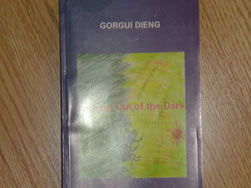 Another book included in the artifact box is an English language novel about language policy in contemporary Africa , and about the relation between Africa and its Diaspora: A leap out of the Dark (2002) by G. Dieng.
Another book included in the artifact box is an English language novel about language policy in contemporary Africa , and about the relation between Africa and its Diaspora: A leap out of the Dark (2002) by G. Dieng.
Voix d'Afrique
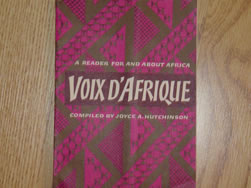 The majority of French language speakers are in Africa , not in France or in North America . A third book to help infuse African content in French language training is included here for that reason: Voix d'Afrique. A Reader for and about Africa by J. A. Hutchinson (1967). Admittedly a dated example included to suggest ways in which the Amin and S. Dieng books also included in the # 3 box can be used.
The majority of French language speakers are in Africa , not in France or in North America . A third book to help infuse African content in French language training is included here for that reason: Voix d'Afrique. A Reader for and about Africa by J. A. Hutchinson (1967). Admittedly a dated example included to suggest ways in which the Amin and S. Dieng books also included in the # 3 box can be used.
A Baye Fall woolen cap

This artifact illustrates the crafts of one sector within the Mouride African Muslim Brotherhood, called the Baye Fall, who worship through constant work. This artifact was acquired at the market in Touba, the holy city of that Senegalese brotherhood.
Visit the Fowler Museum (UCLA) Passport to Paradise exhibit.
Baye Fall
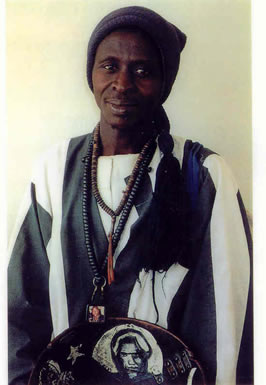
The English Language textbooks

The English language textbooks for the course plan are included: a) The Servants of Allah (1998) by S. Diouf presents the cultural impact of West African Muslims displaced to the Americas during the slave trade; b) The Black Jacobins (2001) by C.L.R. James presents the problem solving methods transmitted by the African Muslims brought to the Caribbean; and c) Children of Segu (1989) by M. Conde presents a 19th Century popular movement of migrant Muslims in West Africa and their connections with the Caribbean . These cultural movements opposing slavery, colonialism, and the technologies of industrialization were precedents for the current international struggles with economic and cultural impositions.
El-Hadj Omar. La Perle de Islam(n.d.) by S. Dieng
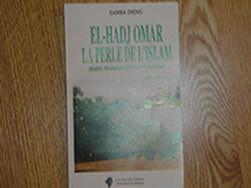
El-Hadj Omar. La Perle de Islam (n.d.) by S. Dieng, a French language book about the Senegalese founder of a 19th Century West African Muslim popular movement, and a graphic image of its founder named El-Hadjj Umar Tal. The maps illustrating that 1854-1900 period are included with the picture of Umar Tal.
Two French language books on globalization
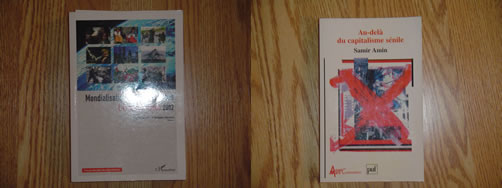
Two French language books on globalization by Egyptian economist Samir Amin are included: a) Au -dela du capitalisme Se'nile [Beyond senile capitalism] (2001); and b) Mondialisation des resistances. L'Etat des lutes [Globalization of resistances. The state of the struggles] (2002). These books present the 21st Century struggles with colonialism, enslavement, and technologies of industrialization.
Few other items in the inventory box 3:
A video of "Le Franc"
A video of "Le Franc" (1994) by D. D. Mambety about urban life in contemporary [1975-2000] Senegal . Good to set the stage for questions that will inform student searches into 19th Century social history. The website for the Cultural Connections: from Senegal to your Classroom project has links to the California Newsreel web site which has material about this film and how to use it in the classroom. The continuous colonization even after independence is represented in this film. This should raise questions about the origins, and previous cases of effective resistance to ongoing colonialism.
Journal article by Senegalese writer Bakary Sambe
Regards Africains , No. 47-48 (2002). [French language] Journal issue on Durban , South Africa United Nations conference about racism held August 2001. Included here in the artifact box is a copy of a journal article by Senegalese writer Bakary Sambe about the history of encounters between Arabs and Africans in the context of Islam, [There will be an English language version of the article in the artifact box.]
Images from museum reproductions(4)
There are four (4) images from museum reproductions acquired at The Institute of the Arab World in Paris, France included in the artifact box:
- A Sufi [Muslim mystic] dancer illustrates one of the practices of the Muslim brotherhoods.
- An Islamic story teller illustrates the historic practice of teaching through stories, and one of the sites where Arabs and Africans met to learn from each other.
- A desert caravan illustrate nomadism, migration and pilgrimages.
- A traditional Muslim dagger illustrates the intersection of religion, politics, and art.
Cassette
A copy of a cassette includes "Taara" (n.d.) performed by Baaba Mal. There is a Fulani, French and English transcript included in the # 3 artifact box. This song from Northern Senegal ,, illustrates the current version of a 14th Century epic poetry form adapted in the 19th Century to transmit memories of opposition to colonialism by the Tidjannia Brotherhood of African Muslims.Course Plan
The course plan was designed for an upper level undergraduate university course about non-western societies, but the teaching units can be adapted to elementary, intermediate and secondary school, as well as survey college courses.